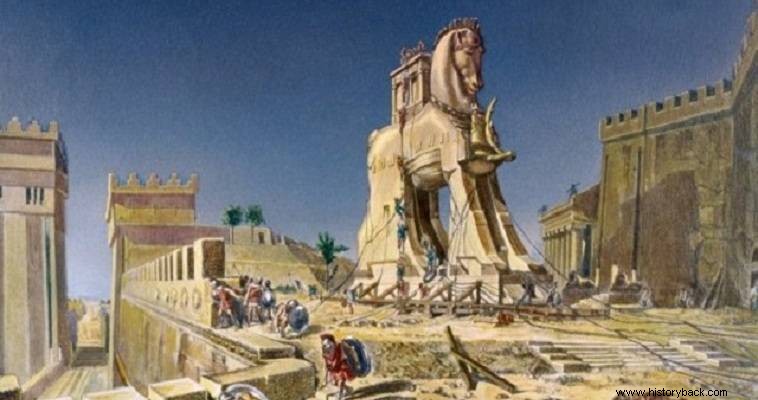
"The fact that this work of Epius (the builder of the Trojan Horse) was a device for the dismantling of the wall is known to anyone who does not consider the Phrygians completely stupid" (Attica, I 23.80). With this phrase, Pausanias describes the Trojan Horse, the first machine for dismantling the wall used by the Greek army.
The "Phrygians" (Trojans) were not foolish enough to tear down their own walls to bring a wooden horse into their city. Instead it was the "wooden horse" that broke down their walls and allowed the Achaeans to enter the city. But what was this wooden horse, the Trojan Horse?
According to the legend, the Achaeans, frustrated by the long siege of Troy, decided to try their luck with a ruse. The Phocaean engineer Epios, built a hollow wooden horse, inside which some Achaean warriors hid.
When the Trojans brought Hippo inside the walls, the imprisoned Achaeans came out secretly, opened the gates and thus the rest of the Mycenaean army entered the city and conquered it. This is what the legend says. But what is hidden behind this romantic tale?
An early Elepolis?
The texts of the epic cycle make extensive references to the work of Epios. According to the descriptions, it was a huge construction, for the measures of the time, dimensions, within which or for the handling of which 3,000 men were required (Mikri Ilias).
Later writers considered this number excessive and brought it down to 100, 50, and just 12 men. Moreover, in representations – the oldest of which go back to geometric times – the Trojan Horse is naturally depicted as a wooden horse, laden with warriors.
At this point, however, it would be appropriate to explicitly mention that siege engines were already known from the 18th century BC. In Egyptian tombs, from the period of the Old and Middle Kingdom, there are representations of siege engines (wheeled ladders, siege rams, etc.).
The Hittites also had similar machines. It must therefore be considered improbable that the Greeks, who had developed such close relations, both with the Egyptians - with whom they fought against the Hyksos, in this very period (16th century BC) - and with the Hittites , that they did not know the existence of even simple siege engines.
As for the number of 3,000 men mentioned in the Little Ilias, although at first it seems indeed excessive, it is identical to the number of men required to handle a typical Hellenistic city. And the Little Ilias was written 300 years earlier than the Hellenistic period!
"Beastly" machines
Wheeled siege engines (which some imaginative people equate with tanks) were widely used, from the 10th century BC. at least, the Assyrians. But since nothing in history is due to parthenogenesis, it is very possible that the Assyrian know-how came from neighboring cultures.
It is also no coincidence that the siege engines of the Assyrians were often animal-shaped and almost always bore the names of animals (e.g. rhinoceros).
Based on the above it can be concluded, with relative safety, that the Trojan Horse was a wheeled vehicle covered and lined with animal skins so that it would not catch fire, a ram, for the movement and use of which a large number of men were required. The Achaeans' only problem would be to "convince" the Trojans to "allow" the machine to approach their walls.
This is precisely what the latter feared and for this reason they resisted a fierce and active defense, delaying, as much as they could, the approach of the enemy to their walls. Once the Achaeans were able to approach the walls and set the engine in motion, the outcome of the siege was certain.
After all, the siege of Troy apparently lasted only a few months. That is, as long as it took for the Achaeans to force their opponents to confine themselves to the walls. Homer describes the events of only 51 days of the siege.
